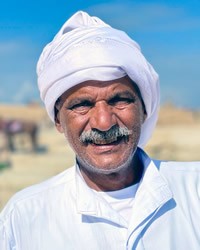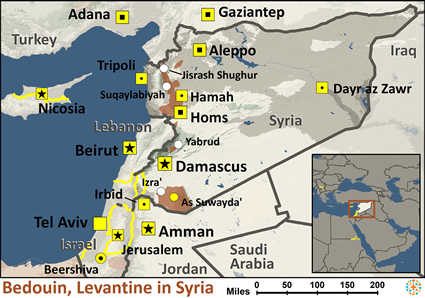The traditional homeland of the Bedouin Arabs is the Arabian Desert. Some Bedouin groups have migrated north into the Negev Desert region of Israel, the West Bank, Gaza, and also Lebanon. Among these are the Levantine Bedouins. The largest of these groups are the Banu Sakhr and the al-Huwaytat.
The Bedouin fall into two basic social classes. One class is known as the "true" Bedouin, and they live as nomadic shepherds. The other group has embraced farming and is known as the fellahin. The fellahin lead a more settled life on the edge of the desert. In contrast, the "true" Bedouin have been known for raiding any caravans that cross their path while journeying across barren deserts. They move into the desert during the rainy winter seasons and back to the desert's edge during the hot, dry summers. They speak Eastern Egyptian Bedawi Arabic.
The material culture of the Levantine Bedouins is limited. Their tents are their main possessions, and animals are very important for their nomadic lifestyle. Camels are their primary means of transportation, while sheep and goats are bought and sold.
The Levantine Bedouin have a relatively harsh existence. To endure the extreme heat of the desert, the Levantine Bedouins wear lightweight, light-colored clothing. It is very loose-fitting, allowing for the circulation of air. The nomads have no permanent homes, but live in portable, black tents made from woven, goat hair. The tents are divided by a decorative partition called a gata. Half of the tent is for the women, children, cooking utensils and storage. The other half contains a fireplace and is used for entertaining. The women do most of the work, while the men socialize and make plans for the group. Serving coffee to guests is important. The host first roasts the coffee beans then pound-grinds them. He serves his guest three cups. The host must drink the first cup to show the guest that it's safe to drink.
Dairy products are the main food source for the Levantine Bedouins. Milk from camels and goats is made into yogurt and butter. Most of their meals consist of at least a bowl of milk, yogurt or rice. Round loaves of unleavened bread are served when available. Dates, which can be found in desert oases, are eaten for dessert. Meat is only served on special occasions such as marriage feasts, ceremonial events or when guests are present.
The overwhelming majority of the Levantine Bedouins are Sunni Muslims. Islam is based on the teachings of the prophet, Mohammed. The Koran ("holy book" of Islam) was supposedly given to Mohammed by the angel Gabriel.
Islam is a religion of works centered on five basic "pillars."
(1) A Muslim must affirm that "there is no god but Allah, and Mohammed is his prophet."
(2) Five times a day he must pray while facing Mecca.
(3) He must give an obligatory percentage (very similar to tithes) on an annual basis.
(4) He must fast during Ramadan, the ninth month of the Muslim year.
(5) He must try to make at least one pilgrimage to Mecca in his lifetime.
Islam has greatly influenced the lives of the Levantine Bedouin. For example, to preserve their people, the Levantine Bedouin are only allowed to marry those inside their own group. Also, the society is patrilineal, which means that inheritances are passed down through the males.
Evangelization efforts among the Levantine Bedouins are challenging due to the harsh and unsettled nature of their lifestyle. Missionaries must endure the severe conditions of the Negev Desert.
Although the Levantine Bedouins once considered it degrading to have manual labor jobs, this has changed somewhat in recent years. Due to the need for better health conditions, more money, and better living conditions, some have accepted wage-paying jobs. However, most of them still despise this type of work.
To make things worse for the Levantine Bedouins in Syria, the constant war is forcing them to move to safer places.
Ask the Lord to call people who are willing to stay with Levantine Bedouins long enough to disciple new Christian believers.
Pray for the Lord to give Levantine Bedouin leaders dreams and visions of the risen and victorious Lord.
Pray for the Lord to give them hearts that want truth and a willingness to sacrifice everything for it.
Ask the Lord to raise up multiplying fellowships of believers among the Levantine Bedouins.
Scripture Prayers for the Bedouin, Levantine in Syria.
https://www.bing.com/videos/riverview/relatedvideo?q=Syrian+Bedouin&mid=DA15D71774446981378DDA15D71774446981378D&cvid=6FB256175AAF4B9A95D306FD17ECCD34&FORM=VIRE
| Profile Source: Joshua Project |


























